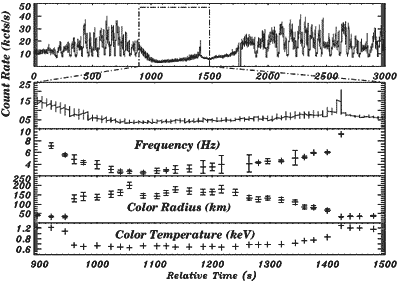


Microquasars - Magnetic Flood Scenario
In 2002, Tagger et al., elaborated on the possible identification of the AEI with the QPO to produce a Magnetic
Flood Scenario (MFS) that would explain the characteristic 30 mn cycle (![]() class of Belloni et al., 2001 ) of
GRS 1915+105.
class of Belloni et al., 2001 ) of
GRS 1915+105.
The MFS explains the repetitive X-ray behavior using a limit cycle determined by the advection of poloidal magnetic flux to the inner disk and its destruction via magnetic reconnection with the magnetic flux trapped close to the source (which can lead to relativistic ejection).
At the beginning of the ![]() class the source is the high
state, accretion is caused by the Magneto-Rotational
Instability (similar to an
class the source is the high
state, accretion is caused by the Magneto-Rotational
Instability (similar to an ![]() prescriprion) which requires
a low magnetic field.
prescriprion) which requires
a low magnetic field.
The vertical magnetic flux builds
up in the disk and the ![]() decreases slowly, until it
reaches
decreases slowly, until it
reaches ![]() .
.
At that point the MRI stops and the AEI starts.
This has two consequences, the temperature decreases with the stopping of turbulent heating,
further decreasing the ![]() and the LFQPO appears (just
before the transition, as it has been observed once).
and the LFQPO appears (just
before the transition, as it has been observed once).
This can explain the abrupt transition observed between the high and low state.

The MFS also leads to a natural explanation of the three basic states (A,B and C) from which all the classes of GRS 1915+105 are derived. In the MFS, state C is dominated by the AEI in the inner region of the disk.
State A is a soft state where the inner disk is weakly magnetized, after magnetic flux has been destroyed by the reconnection event associated with the relativistic ejection that ends state C.
State B is the steep-power law state where magnetic flux has again started piling up near the inner disk edge.
The MFS also provides a natural explanation for the observation that the transition from state C to B is never observed: the disk needs to spend some time in state A in order to rebuild enough magnetic flux in its inner region to transition to state B.